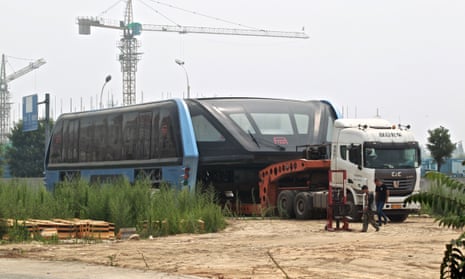The plan always seemed a bit too good – or at least too brilliantly weird – to be true. Last year footage and reports about China’s “straddling bus”, a bizarre vehicle that appeared to glide over traffic on roads, went viral and was touted as a solution to the country’s traffic congestion problems.
Now the project has been scrapped and 32 people have been arrested for alleged illegal fundraising in connection with it. Suspicions about the project, which resulted in the creation of some intriguing videos, have grown.
Not everyone will have been surprised by the news. Doubts over the legitimacy of the Transit Elevated Bus (TEB) and Huaying Kailai, the fundraising platform raising investment for it, were highlighted by Chinese state media last August.
Just before that article ran the company behind the vehicle, TEB Technologies, performed a test run in Hebei province that created a huge buzz. When I subsequently asked the firm if I could visit them for insights into TEB I was rebuffed. Chinese firms failing to help foreign journalists is common, but for a company seemingly eager to attract investment the refusal still seemed a little odd.
There had also been doubts that the bus would be able to manage China’s road system, including corners and footbridges, or if it was even strong enough to bear the weight of passengers.
Now the TEB prototype lies in a rusting state and investors sweat over getting their money back: another example of futuristic transport that makes great headlines, but does not offer a solution to China’s serious traffic problems.
According to Statista, in 2016 China’s vehicle population was 194m – up from 105m five years previously. Between 1982 and 2015 China’s urban population shot up from 21% to 56%, and the government’s target for 2020 is 60%. The fast growing city population combined with rise of car ownership has led to enormous traffic problems in many cities.
In Beijing, which has about 5.6m cars, tough driving restrictions have been introduced in an attempt to cut both traffic and air pollution. It is one of many cities in China to cap the amount of number plates issued annually, implementing a monthly “licence plate lottery”. Applicants face extremely long odds of being granted plates, forcing many to stay off the road for years.
The ambition for Beijing transport authorities is to keep the number of cars in the city below 6.3m by 2020. And while the road-straddling bus has proved a failure, other businesses such as bike-sharing companies like Ofo could have more success.
Ofo has made 40,000–50,000 of its bikes available to hire in Beijing with a GPS system tracking their location and use. They can be unlocked by users using a combination code sent through the company’s app. These and other bike-sharing startups have attracted major investors, including tech giants Didi Chuxing and Tencen.
Last year Pan Yunhe, former executive vice president of the Chinese Academy of Engineering, predicted a future in which bike-share schemes evolved to offer electric mini-cars. Such cars will “probably be a major transportation vehicle in Chinese cities in the future,” he wrote.
While bike-sharing schemes are having a positive impact, policy changes are the key to tackling congestion in Chinese cities, says Lu Daizong, director of the China Cities Programme of the World Resources Institute, a research organisation.
Lu said transport authorities in cities including Beijing, Shanghai, Nanjing and Shenzhen are considering introducing congestion charge zones, having seen them successfully reduce traffic in London, Singapore and Stockholm. Measures such as these, he added, were vital to encourage drivers to use public transport instead of their cars.
“In China we’re focused on technology, but people don’t use public transport because of the technology. They use it because of high-quality service and speed,” he said.

Comments (…)
Sign in or create your Guardian account to join the discussion